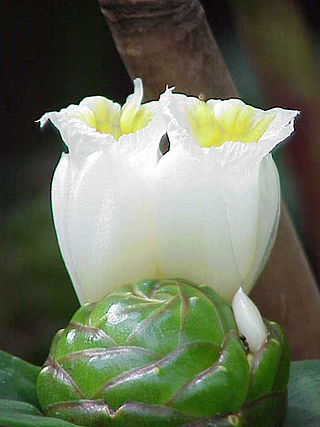
Costaceae, known as the Costus family or spiral gingers, is a family of pantropical monocots. It belongs to the order Zingiberales, which contains horticulturally and economically important plants such as the banana (Musaceae), bird-of-paradise (Strelitziaceae), and edible ginger (Zingiberaceae). The seven genera in Costaceae together contain about 143 known species. They are native to tropical climates of Asia, Africa, Central America, and South America. Several species are frequently found in cultivation.

Triuridaceae are a family of tropical and subtropical flowering plants, including nine genera with a total of approximately 55 known species. All members lack chlorophyll and are mycoheterotrophic. The heterotrophic lifestyle of these plants has resulted in a loss of xylem vessels and stomata, and a reduction of leaves to scales.

Costus is a genus of herbaceous perennial plants in the family Costaceae, erected by Linnaeus in 1753. It is widespread through tropical and subtropical regions of Asia, Africa, and the Americas.
Paulus Johannes Maria "Paul" Maas is a botanist from the Netherlands and a specialist in the flora of the neotropics. Maas has identified and named about two hundred fifty plants from the Burmanniaceae, the Costus Family (Costaceae), the Gentian Family (Gentianaceae), the Bloodwort Family (Haemodoraceae), the Banana Family (Musaceae), the Olacaceae, the Triuridaceae, and the Ginger Family (Zingiberaceae).

Renealmia is a plant genus in the family Zingiberaceae. Its members are native to tropical Africa and tropical America. In Peru, fruits and tubers are sources of indigenous dyes. and indigenous medical treatments for leishmania and malaria In Colombia, it is used to treat snakebite. Bracts and leaves can serve as phytotelmata, retaining small quantities of water that offer habitat for other organisms.

Hillegonda (Hiltje) Maas-van de Kamer is a botanist at the Institute of Systematic Botany at Utrecht University. She is the wife of Professor Paul Maas and together they have published many papers. She is a specialist in the flora of the neotropics.

Atractocarpus chartaceus, commonly known as the narrow-leaved gardenia, is a species of evergreen flowering plant in the coffee family Rubiaceae. It is found in subtropical rainforest of eastern Queensland, Australia, and it is cultivated for its fragrant flowers and colourful fruit.

Costus osae is a species of flowering plant in the family Costaceae. One of many rare tropical plants in the Costus family, Costus osae is a species native to Costa Rica described in 1997 by Paul Maas and Hiltje Maas-van de Kamer. It has also been reported from Colombia.
Passiflora viridescens is a plant species native to Perú and Ecuador.
Costus curvibracteatus is a tropical rhizomatous perennial native to Costa Rica and Panama.

Costus claviger is a species of flowering plant from the genus Costus.

Costus woodsonii, the red button ginger or scarlet spiral flag, is a species of flowering plant in the family Costaceae, native to Nicaragua, Costa Rica, Panama, and Colombia. A rhizomatous geophytic perennial, it is recommended for coastal gardens, borders, containers, and general wet, tropical garden applications. It is more widely cultivated than other species of Costus. Costus woodsonii was first described by Paul Maas in 1972 and is named for Robert Woodson of the Missouri Botanical Garden.

Costus pulverulentus, the red cigar or spiral ginger, is a species of flowering plant in the family Costaceae. It is native to Mexico, Central America, Colombia, Venezuela, and Ecuador, and it has been introduced to Cuba and Florida. It is invasive in Hawaii.

Costus dubius is a species of plant native to Tropical Africa.

Costus lucanusianus is a species of plant native to Africa. It is widely distributed across North East Africa, West Africa, Central Africa, East Africa, and Southern Tropical Africa.

Costus comosus, known as red tower ginger, is a species of plant native to South Mexico to Ecuador.

Costus afer, English ginger lily or common ginger lily, is a species of plant native to Tropical Africa.

Costus productus, known as orange tulip ginger, dwarf orange ginger, or green mountain spiral flag, is a species of plant in the Costaceae family. Costus productus is native to South Colombia and Peru.
Costus longibracteolatus is a species of flowering plant in the genus Costus. Its native range is western South America to Guyana, where it grows in forests at lower elevations. Costus longibracteolatus was first described by Paul Maas in 1972.















